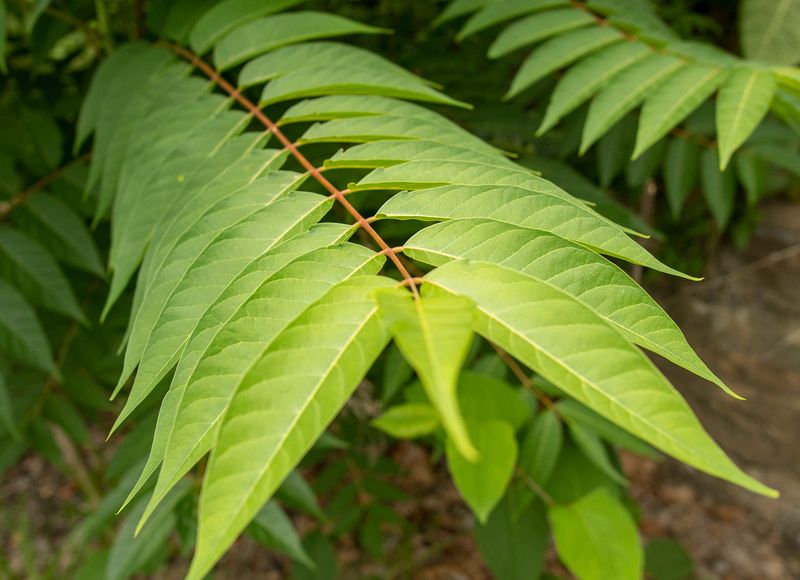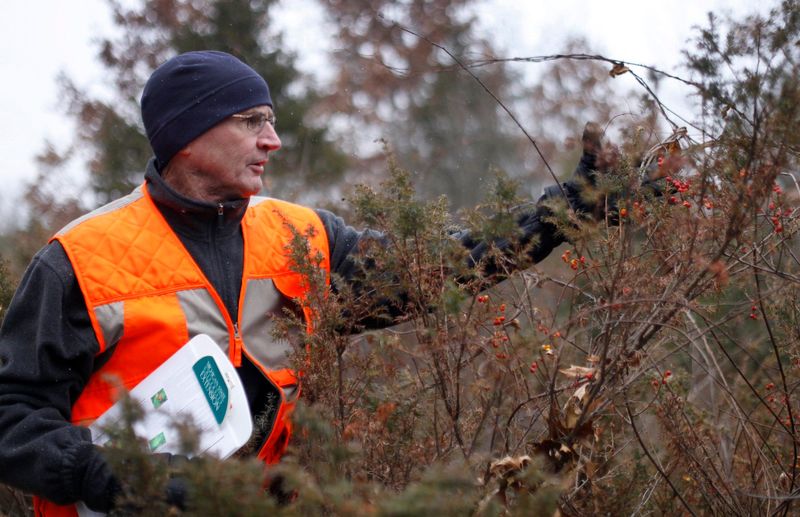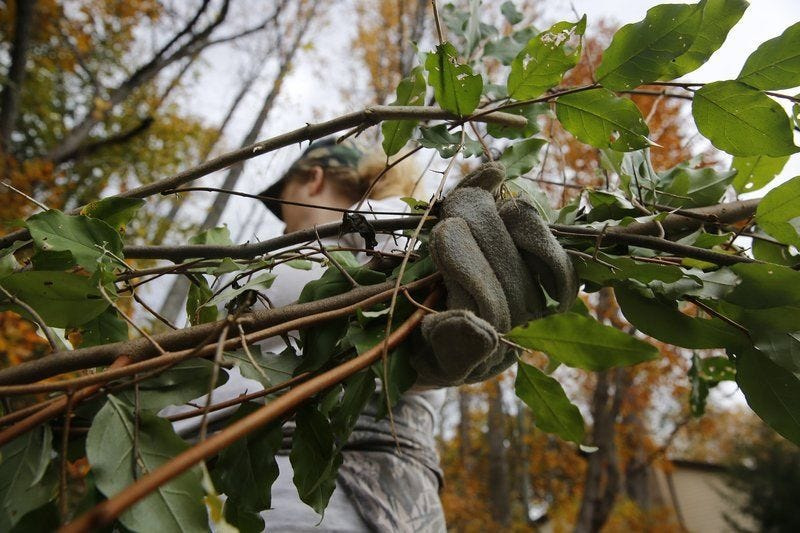Indiana has rich biodiversity with thousands of species in unique habitats, but the ornamental plant trade, globalization and development have introduced new threats to these ecosystems.
In 2020, the Indiana Department of Natural Resources implemented the Terrestrial Plant Rule banning the sale, gifting, barter, exchange, distribution, transportation or introduction of 44 invasive species, like autumn olive, wintercreeper and Japanese stiltgrass. But the move came after many species had found a foothold in the state.

And unfortunately for landowners, many invasive species are also proving to be a nuisance in neighborhoods and urban areas. The plants, which can rapidly take over gardens and front lawns, can be tricky to identify and expensive to remove.
Here are five species to watch for and a few resources in case you find them.
Tree of heaven
The tree of heaven (Ailanthus altissima) is an aggressive, stinky plant that has found its way into many Indiana front lawns.
As it spreads, it chemically attacks nearby species, hurts local bird populations and attracts spotted lanternflies — a highly invasive pest. Adding insult to injury, the whole plant smells like rotten peanut butter.
“A lot of people have very good intentions and would like to get rid of invasive trees in their yard, but it costs real money. It’s not like digging out a little shrub,” said Ellen Jacquart, a retired botanist and president of Monroe County – Identify and Reduce Invasive Species (MC-IRIS).
Scientists suggest a multifaceted attack against the trees. When they’re small, manually digging them up year after year can help keep an area clear. But you’ll have to repeat the process as roots can persist in the soil and grow new trees. A mature tree of heaven is trickier to destroy. Chopping them down, injecting their bark with herbicide and spraying their stumps can prevent further growth and limit spread.
Wintercreeper
If you’re in the market for a mid-century style home in Indianapolis right now but want to avoid purchasing a lawn full of wintercreeper, good luck. Wintercreeper was brought into the United States as an ornamental landscaping plant more than a century ago, and before its reputation soured, it was a darling of landscapers and homeowners.
“It’s absolutely everywhere,” said John Hazlett, the district manager for the Marion County Soil and Water Conservation District, who is currently in the market for a mid-century home himself.
Experts advise property owners to start small and pick your battles.
“If you have a good strategy, you can absolutely win,” said Cliff Chapman, the president of the Central Indiana Land Trust, who has been battling wintercreeper at Meltzer Woods.
The old-growth forest, full of trees aging past 150 years, was in a state of suffocation when Chapman first stepped inside in 1999. The ground, once bright with a mosaic of native flowers, was carpeted in a thick, monochromatic mat of dark green leaves. This plant also snaked almost 60 feet up into the forest canopy. Bur oak and swamp white oak trees were girdled and sagging under the vine’s grip.
“We’ve been very successful there,” said Chapman. “But we also have to be vigilant. It’s not over. We have to keep going back year after year… and always be looking for what’s next.
Asian bush honeysuckle
While most foliage shrivels and falls to the ground in early November, the small green leaves of the Asian bush honeysuckles are still hanging on, making it easier to identify and eradicate the invasive plant that has spread to almost every county in Indiana.
“Every single county. There is Asian bush honeysuckle within probably 200 feet of where you’re sitting, and I don’t even know where you’re sitting. It’s everywhere,” said Jacquart.
Bush honeysuckles encompass three species that have taken root in the United States: the Tatarian honeysuckle from Russia, the Morrow’s honeysuckle from Japan and the Amur honeysuckle from China. In Indiana, the Amur honeysuckle is a particular threat to forest ecosystems.
Once the honeysuckle finds its way into an area, the plant is quick to suffocate large patches of the understory, crowd out native plants and slow the growth rate of native trees. In suburban neighborhoods, it has a penchant for suffocating living fences built from plants, shrubs or small trees.
Luckily, there are ways to combat the Asian bush honeysuckle, said Jacquart, who works with local park managers, invasive species groups and land owners to control spread. She conducts invasive species surveys and visits homes and teach owners to identify and then root out Asian bush honeysuckle.
Oriental Bittersweet
Brought over from the lowlands of Eastern Asia, oriental bittersweet was planted intentionally in the United States before it started wreaking havoc. The thick, snarling vines that produced bright yellow leaves and orange berries were sought after for holiday wreaths, private landscaping, and the grounds of large arboretums.
But by the 1960s, horticulturists were growing wary. Many of the traits that made oriental bittersweet so appealing — it grows fast and large — gave it the potential to become a pest. And it did.
Birds and other wildlife often feast on oriental bittersweet berries, spreading them as they move. Now, the species no longer just grows where it was planted in front yards and along roadways. In Indiana, oriental bittersweet has migrated uninvited into national and state parks, forest floors and some of the state’s most beloved natural areas.
In its search for ample sunlight, the species tightly snakes up trees. With vines that can grow up to six inches in diameter, the plant can cut off a trunk’s ability to transport water internally. And once atop the forest canopy, oriental bittersweet proliferates far and wide, blocking out sunlight for the understory, which makes it difficult for native plants to survive.
“I have yet to visit one property in Brown County that is free from Oriental bittersweet,” wrote Dawn Slack, the Indiana Invasives Initiative coordinator for the State of Indiana Cooperative Invasives Species Management, in an email to IndyStar.
Pear trees
Tree breeders on an agricultural mission brought the unassuming Callery pear (Pyrus calleryana) tree into the United States in the early 1900s. They planned to breed the species with vulnerable pear crops in the Pacific Northwest to create a new tree resistant to a deadly fungus threatening the industry.
They succeeded and then some. What ensued has become a widespread ecological disaster. The resulting pear trees have spread far and wide from where they were planted, stifling native biodiversity every step of the way.
From the original Callery pear, horticulturists bred a consumer-friendly variety: the Bradford pear. It lacked thorns and was hypothetically sterile — perfect for homeowners looking for small, manageable trees that wouldn’t prove too unwieldy.
But Bradford pears are not completely sterile, horticulturists later discovered. When other varieties are planted nearby, the trees can cross pollinate and send fertile seeds out to grow nearby.
The trees that once just speckled the landscapes where they were deliberately placed have now invaded state highway berms, fields, forests and wetlands. In Indianapolis, planted prairies that once boasted native grasses and flowers have been consumed by Callery pear trees and their relatives. In wooded areas, the species is invading the understory, crowding out native plants and biodiversity.
Biologists have one simple wish.
“Please cut them down,” wrote Dawn Slack, the Indiana Invasives Initiative coordinator for the State of Indiana Cooperative Invasives Species Management, in an email to IndyStar. “To be frank, if we continue to adorn our landscapes with invasive plants from other countries (in essence celebrating the natural beauty of other countries instead of our own), then we are negatively impacting this country.”
The list of invasive species you might have crawling all over your backyard is lengthy. Hoosiers are also battling English ivy, Canada thistle, white mulberry, burning bush, and autumn olive.
If you have something pesky crowding out your yard, you can learn more about how to remove it by contacting your regional specialist at the State of Indiana Cooperative Invasives Management.
IndyStar’s environmental reporting is made possible through the generous support of the nonprofit Nina Mason Pulliam Charitable Trust.
Sophie Hartley is an IndyStar environment reporter. You can reach her at sophie.hartley@indystar.com or on X at @sophienhartley.
This article originally appeared on Indianapolis Star: 5 invasive plants that could be putting down roots in your garden or lawn
Reporting by Sophie Hartley, Indianapolis Star / Indianapolis Star
USA TODAY Network via Reuters Connect






